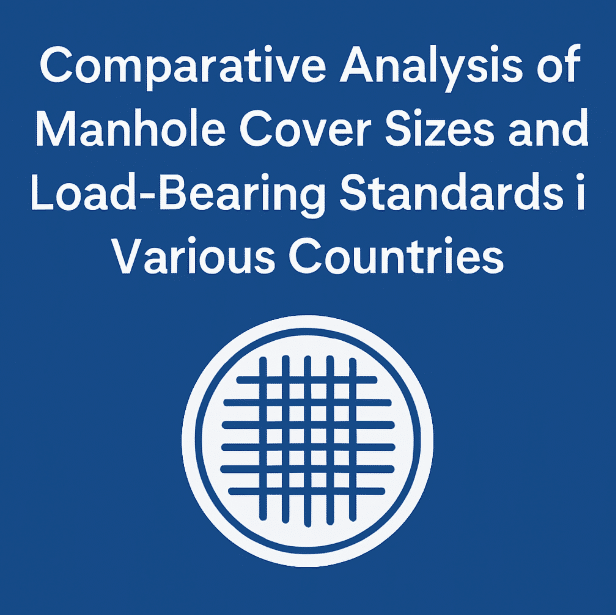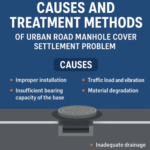Manhole covers serve as critical infrastructure components, enabling secure access to underground utilities while ensuring road surface integrity and public safety. However, size and load-bearing standards for manhole covers vary significantly across countries. These variations stem from differences in traffic load, urban design, and local engineering codes. This article offers a professional comparative analysis of manhole cover dimensions and strength classifications used worldwide, emphasizing how regional standards reflect infrastructure demands and regulatory priorities.
Standard Manhole Cover Sizes by Country
United States
In the United States, most municipalities adhere to the AASHTO M306 and ASTM A48 standards for ductile and gray cast iron covers. The most common size is 24 inches (610 mm) in diameter for circular covers, which balances accessibility with strength.
- Design preference: Circular covers are prevalent due to their safety advantages and ease of handling.
- Standard depth: 1.5 to 2 inches (38–51 mm)
- Materials: Predominantly ductile iron and composite for urban and light-duty areas
United Kingdom & Europe
European countries primarily use the EN 124 standard, which classifies manhole covers from Class A15 to F900, depending on their load-bearing capacity.
- Typical size: 600 mm × 600 mm square or 600 mm diameter round
- Material usage: Ductile iron, cast iron, and composite covers
- Key feature: Detailed load classes such as:
- A15: 1.5 tonnes (pedestrian areas)
- D400: 40 tonnes (roadways)
- F900: 90 tonnes (airports and docks)
China
China adopts the GB/T 23858-2009 and CJ/T 121-2000 standards for municipal manhole covers. The most popular sizes include:
- 700 mm diameter for vehicle-bearing applications
- 400–600 mm for residential and pedestrian zones
- Load classes align closely with EN 124, though tolerances can vary.
Australia
Australian standards (AS 3996:2019) classify manhole covers by load rating from Class A (non-trafficable) to Class G (extreme heavy-duty).
- Standard dimensions: 600 mm diameter
- Unique approach: Focus on environmental sealing and slip resistance, especially in flood-prone areas
Middle East & Gulf Countries
Gulf countries like the UAE and Saudi Arabia follow a mix of EN 124 and customized municipal specifications due to extreme climate conditions and sand load.
- Standard sizes: 600 mm or 800 mm
- Common load classes: D400 and E600 for heavy-duty roadways
- Material: Composite is increasingly used due to resistance to corrosion and theft
Global Load-Bearing Standards Compared
| Standard | Country/Region | Load Class | Maximum Load | Typical Application |
|---|---|---|---|---|
| EN 124 D400 | EU, UK | D400 | 40 tonnes | Public roads, urban areas |
| AASHTO M306 | USA | HS-20 | 36 tonnes | Highways |
| GB/T 23858 | China | D400 | 40 tonnes | City streets |
| AS 3996 Class D | Australia | D | 210 kN (21 tonnes) | Roadways |
| EN 124 F900 | Airports, ports | F900 | 90 tonnes | Runways, docks |
Factors Influencing Size and Load Selection
- Traffic Load: Heavily trafficked areas require covers with higher load ratings (e.g., EN 124 D400 or F900).
- Cover Shape: Round covers reduce the risk of falling into the manhole and are easier to align during installation.
- Installation Environment: Areas prone to theft or corrosion may prefer composite materials over traditional metal covers.
- Cost and Lifecycle: Regions with limited budgets may opt for standardized sizes to streamline manufacturing and replacement logistics.
Transitioning to Composite Covers Globally
Many cities are transitioning from cast iron to composite manhole covers due to the latter’s lightweight nature, corrosion resistance, and reduced risk of theft. While composite options are not yet universal in heavy-duty applications, their performance under Class B125 and C250 makes them suitable for sidewalks, parks, and light-traffic roads.
Conclusion
Understanding the variation in manhole cover sizes and load-bearing standards is crucial for infrastructure planners, engineers, and procurement officers. By aligning with internationally recognized standards like EN 124 or AASHTO M306, project managers can ensure durability, safety, and regulatory compliance. For projects that span multiple countries or involve international suppliers, standardized sizing and quality benchmarks become even more vital.
Frequently Asked Questions (FAQ)
Q1: Why do manhole cover sizes differ between countries?
A: Size variations arise due to local traffic patterns, regulatory standards, climate, and urban planning needs.
Q2: Which standard is the most commonly used worldwide?
A: EN 124 is widely accepted across Europe, Asia, and the Middle East for its comprehensive classification and safety metrics.
Q3: Are composite manhole covers suitable for heavy traffic?
A: Advanced composite covers are increasingly viable for medium-duty applications, though ductile iron remains preferred for high-load zones.
Q4: What is the best option for anti-theft and corrosion resistance?
A: Composite covers are ideal due to their non-metallic composition and durability in harsh environments.
Q5: Where can I source high-quality and affordable manhole covers?
A: Xinghua Casting offers a broad range of cast iron and composite manhole covers that meet international standards. Their products are known for excellent quality and competitive pricing, making them a reliable choice for global buyers.





